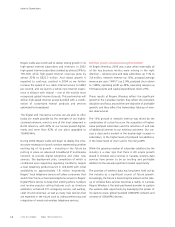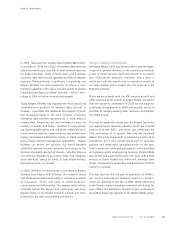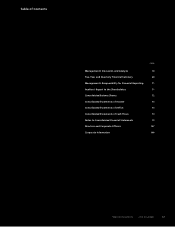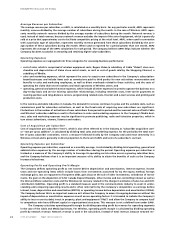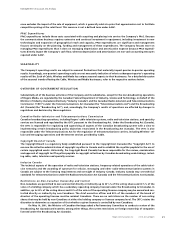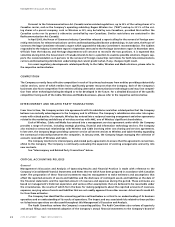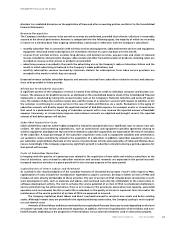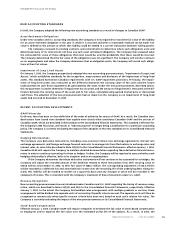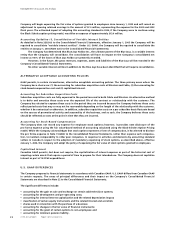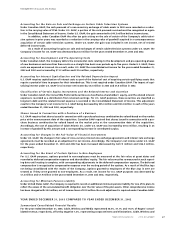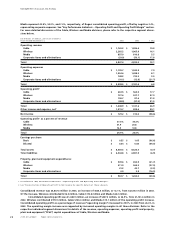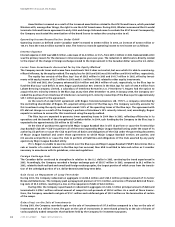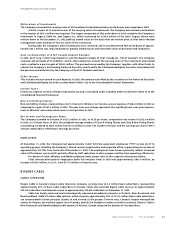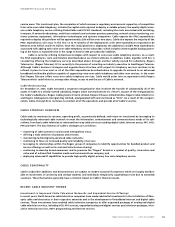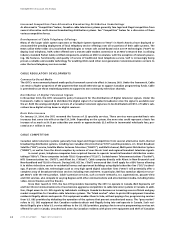Rogers 2003 Annual Report Download - page 26
Download and view the complete annual report
Please find page 26 of the 2003 Rogers annual report below. You can navigate through the pages in the report by either clicking on the pages listed below, or by using the keyword search tool below to find specific information within the annual report.
2003 Annual Report Rogers Communications Inc.
24
The percentage of direct labour capitalized is determined, in many cases, by the nature of activities in a specific
department. For example, all labour and direct overhead of the construction departments are capitalized as a result of
the nature of the activity performed by those departments. In some cases, the amount of capitalization depends on the
level of maintenance versus capital activity that a department performs. In these cases, an analysis of work activity is
applied to determine this percentage allocation.
Depreciation Policies and Useful Lives
The Company depreciates the cost of PP&E over the estimated useful service lives of the items. These estimates of useful
lives involve considerable judgment. In determining these estimates, the Company takes into account industry trends and
company-specific factors, including changing technologies and expectations for the in-service period of these assets.
On an annual basis, the Company reassesses its existing estimates of useful lives to ensure they match the anticipated life
of the technology from a revenue producing perspective. If technological change happens more quickly or in a different
way than the Company has anticipated, the Company might have to shorten the estimated life of certain PP&E, which
could result in higher depreciation expense in future periods or an impairment charge to write down the value of PP&E.
Asset Impairment
The valuations of all long-lived assets, along with spectrum licences and goodwill, are subject to annual reviews for
impairment.
A two-step process determines impairment of long-lived assets. The first step determines when impairment must
be measured and compares the carrying value to the sum of the undiscounted cash flows expected to result from their
use and eventual disposition. If the carrying value exceeds this sum, a second step is performed, which measures the
amount of the impairment as the difference between the carrying value of the long-lived asset and its fair value calculated
using quoted market price or discounted cash flows. An impaired asset is written down to its estimated fair market value
based on the information available at that time. Considerable management judgment is necessary to estimate discounted
cash flows. Assumptions used in estimating these cash flows are consistent with those used in internal forecasting and
are compared for reasonability to forecasts prepared by external analysts. Significant changes in assumptions with
respect to the competitive environment could result in impairment of these assets.
In testing for impairment of goodwill, the Company conducts a two-step process. In the first step, the fair value of
the Company is compared with its carrying value. If the fair value exceeds the carrying value, no impairment is consid-
ered to have occurred. The second step is performed when the carrying value of the Company exceeds its fair value, in
which case the implied fair value of the Company’s goodwill is determined in the same manner as it would be determined
in a business combination.
Spectrum licences are tested for impairment by comparing their fair values with their carrying values. When fair
values exceed carrying values, no impairment is considered to have occurred.
The Company cannot predict whether an event that triggers an impairment will occur, when it will occur or how it
will affect the asset values reported.
The AT&T brand licence, acquired in 1996 at an aggregate cost of $37.8 million, which provided Rogers Wireless
with, among other things, the right to use the AT&T brand name, was determined to have no remaining useful life at
December 31, 2003 as Rogers Wireless had announced its intention to terminate this brand licence agreement in early
2004. The remaining book value of $20.0 million was therefore fully amortized. See “Related Party and Intercompany
Transactions” for a further discussion of this item and Note 5(b) to the Consolidated Financial Statements.
Pension Assumptions
On an annual basis, the Company reviews assumptions related to defined benefit pension plans. As a result, the assump-
tions related to the weighted average discount rate for accrued benefit obligations remains at 6.25%, the weighted
average expected long-term rate of return on plan assets remains at 7.25% and the assumption with respect to the
weighted average rate of compensation increase has been reduced from 5.0% to 4.0%. The Company anticipates that cash
contributions to the defined benefit pension plans will be approximately $9.7 million in 2004.
Contingencies
The Company is subject to various claims and contingencies related to lawsuits, taxes and commitments under contrac-
tual and other commercial obligations. The Company recognizes liabilities for contingencies and commitments when a
loss is probable and capable of being reasonably estimated. Significant changes in assumptions as to the likelihood and
estimates of the amount of a loss could result in recognition of an additional liability.
Related Party Transactions
All material related party transactions are reviewed by the Audit Committee of the RCI Board of Directors. Refer to
“Intercompany and Related Party Transactions” below and to Note 17 to the Consolidated Financial Statements for addi-
tional information on related party transactions.
Management’s Discussion and Analysis


